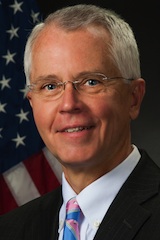
Late last month, the U.S. Environmental Protection Agency (EPA) and the U.S. Army finalized the Clean Water Rule. It was more than a year in the making, and there has been much talk among members of the landscape industry and its trade organizations about how certain provisions could affect landscape and lawn care operators.
LM posed some of those concerns to Ken Kopocis, EPA’s deputy assistant administrator,
Office of Water, in a new feature called “5 Questions with…” Here’s the interview, which has been edited for length and clarity.
1. There’s a public safety concern that the inability to use certain pesticides near bodies of water will cause more people to contract diseases, such as mosquito-borne illnesses, etc. Can you speak to what considerations EPA made regarding these concerns?
Ken Kopocis (KK): Of course, the rule is about which waters are or are not regulated under the Clean Water Act. We have a general permit in existence that says how you can use pesticides and stay in compliance with the Clean Water Act. Largely, it requires an applicator to follow label directions and if pesticides are approved to address mosquitoes, they’ll be able to continue to use it. The rule isn’t going to have any adverse effect. To date, we’ve receive no information that someone was unable to treat for mosquitoes or any other pest that need to be sprayed.
2. How about permitting? EPA said there are no new permits required for farmers. How about for landscape professionals?
KK: Our general permit for applying pesticides applies to anybody who’s putting on pesticides near or around waters, whether it’s for farming, landscaping or forestry. In essence, follow the label directions and avoid spraying directly into the water.
3. There has been speculation that companies might need a permit to plant a tree. Is there any scenario where that could be the case? Also, EPA said the new rules will “(make) permitting less costly, easier, and faster for businesses and industry.” How so?
KK: I’m struggling to think of an example where that would be the case. In the proposal we talked about adjacent waters in the flood plain, but it would only apply to waters. If there were wetlands within a flood plain that are under Clean Water Act jurisdiction, it would depend on the size of the planting. Depending on size, you may need to notify your local Army Corps of Engineers office.
The jurisdictional determinations require extensive analyses that could take a year or more. In this rule, we’ve provided more information, so jurisdictional information could be decider quicker. Even where you’re going to do a case-specific analysis, they’re limited to the 100-year flood plain, and people will be able to go out and measure if they’re in out or out of the jurisdiction of the Clean Water Act.
4. Talk about enforcement and implementation? How will it be different?
We do not anticipate any change in our enforcement policies related to the Clean Water Act. We expect those to be the same. As far as implementation goes, the rule itself will become final and effective 60 days after it’s published in the Federal Registrar, and we’re expecting it to be published in the next several weeks. So you’re looking at it becoming effective in late August or early September. During that time we’re engaging in extensive amount of outreach so we can talk with communities and answer the questions they have, in Washington and out, working with our regional offices and districts and with the Corps.
5. Are there any other ways the new rule might affect the landscape industry day to day?
KK: We think they’ll see virtually no change in their day-to-day operation. Our experience has been, for people who go out and do landscaping, they know if they’re working in a wetland or on a stream [and if] they need a permit to do it. We don’t see any real change in that area for people in the landscape industry. We wanted to be careful we got those waters that needed to be captured and stayed away form those that did not.

